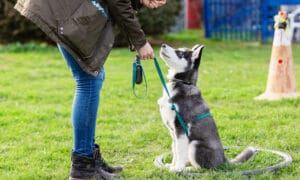“This post contains affiliate links, and I will be compensated if you make a purchase after clicking on my links.”

1. Keep it Simple.
Dogs can learn complex behaviors if taught in steps. Keeping it simple and breaking individual behaviors into steps will help your dog learn faster. An example would be if you wanted your dog to go to its bed when a guest arrives. Firstly, you would need to teach him what his bed is. From there you need to teach him how to stay on the bed. These first two things are what I would focus on in the beginning. Once the dog knows how to stay on the bed, you can introduce people entering the home. By breaking it into steps like this, you will see results quicker than if you try to only train this behavior when a guest arrives.
2. Keep it Positive.
By staying positive and teaching your dog in an encouraging way, you will see quicker results that last longer. What I mean by this is don’t yell at your dog if it makes a mistake. Instead, think about what you would like your dog to do and show him how to do it. No I don’t mean act like a dog, I mean Keep it Simple. Using positive reinforcement is a fantastic tool to use for building new behaviors. In order to use it, you just need to find something your dog really enjoys, and give it to him after he does something you like. (It is a tiny bit more complex than that but it’s the overall idea.)
3. Lots of Repetition.
Repetition in training is one of the most important things. When teaching your dog something new, you have to practice. Every dog is different so there isn’t really an overall answer as to how much repetition is needed. The best way to do it is to Keep it Simple and Keep it Positive. By keeping it simple and positive you should need less repetitions to get to the desired point. Typically my answer when someone asks me why their dog isn’t doing very well at something is because they haven’t done enough repetitions of it.
4. Stay Consistent.
Consistency is another very important key when training a dog. Consistency means making rules and following through with them. The most well behaved dogs come from consistent owners. Often times when an owner isn’t consistent, the dog ends up getting away with anything that it wants. This can be bad because when a dog gets away with what it wants, its behaviors are most likely getting reinforced. Since these behaviors are getting reinforced they get worse and worse until the human doesn’t know what to do. Remember to teach your dog what you want it to do, and then consistently reward that behavior. This will work out way better than waiting for the dog to do the wrong behavior and trying to consistently punish it.
5. Exercise.
One of the most important things to do when trying to have a well-behaved dog is making sure that its mental and physical needs are met. Just about every dog needs exercise. Physical exercise is great because it helps keep your dog in shape. It also lowers the amount of juice in the dog’s “battery.” Some sort of physical exercise should be done daily. Mental exercise is a better way to tire a dog out. Working a dog’s brain for ten minutes is equivalent to roughly 30 minutes of physical exercise. I recommend doing 2-3 ten-minute training sessions daily. These sessions can include regular obedience, or even teaching tricks. The idea is to make the dog think. When doing this, remember to Keep it Simple, Keep it Positive, do Lots of Repetition, and to Stay Consistent.
Kevin is a Certified Professional Dog Trainer through the Certification Council for Professional Dog Trainers (CCPDT.org) and is a Canine Good Citizen Evaluator through the American Kennel Club. He currently resides in Ohio with his dog, V, a six-year-old Shepherd/Lab mix, where he operates All Dogs Go To Kevin, LLC, specializing in helping build positive relationships between humans and their canine companions using clear communication, not pain and fear. For more training tips and tricks, and to meet his amazing dog, V, follow him on Facebook by clicking here.
Do you have a tough training question to ask? Click HERE to “Ask the Trainer!”



















Louise
May 30, 2014 at 10:06 am
My dog is really, really attached to us. She’s an 8 year old Chihuahua/Dachsund mix (more Dachshund, the Chihuahua) and weighs 8 lbs. We rescued her 3 months ago. She yaps when we leave her and when we come home (but I think that’s when she actually here’s us coming in the house if we sneak it she’s not yapping). My concern is if we ever have to leaver her at a kennel how she will be able to handle that issue. We want to take vacations but we are very concerned she will be depressed the whole time we are away. We love her madly which makes this very difficult.
Tara Fawcett
May 30, 2014 at 10:13 am
If your dog gets along with other dogs i would recommend asking a frien or relative if they would watch him instead of a kennel. Since the dog is still new to you he might withdrawal. If left in a cage for a long period of time(like a kennel does). Just my suggestion.
Kathy
May 30, 2014 at 12:42 pm
I have a 5 year old dachshund/chihuahua/basset hound mix that I rescued two years ago. He is an amazing dog as well, but he suffers from separation anxiety. It sounds like perhaps yours might too? Ours will carry on and bark and howl when we leave and while we are away. I was going to say however, that our dog acts so different at doggy daycare (which is where we also board him) than he does at home. I’d recommend a place like that to board your dog for a couple different reasons. 1- doggy daycare usually has regular looking rooms not kennels where they stay overnight which makes them feel like they’re at home. Also, if your board them at daycare, during the day they get to play all day and be out interacting with other dogs! It’s great socialization and it keeps them happy so theyre not sitting in a kennel all day! So do some research and see if you local doggy daycare and see what kind of facilities they have.
Jeff Keith
May 31, 2014 at 11:36 pm
I have had a Dachshund since I was 10, started out with a Standard Smooth, and have had all three coat types, ( Smooth, Wire, Long Hair) all seem to have different temperaments, as do the different sizes and Personalities. The integration of usually two or more, will mellow each other down and take care of any stress issues, especially if you have the GREAT Fortune of having a Good Friend who placed her finished Champion with me after her spaying after almost loosing her. She became one of the pack but she also was able to teach the others how to act Show behavior, and take everyone into the bathroom and bath them in the shower, and towels ready, also have the nail clippers ready do all nails while they are softer from the water. They learn that Everyone gets the same treatment, Grooming time gives you the opportunity to have your hands on their bodies often in ways they do not appreciate. If I have to be gone overnight, I have a friend or thankfully my Mom come over into their home, and Dog sit. They ENJOY having their own beds to sleep in and with someone they know! One thing I FIRMLY believe in is RESCUE RESCUE RESCUE, do not breed unless your attempting to improve the breed in some way. Best Wishes, I have currently, #3 #15yr Shitsu, Poodle, Long Hair Dachshund, #1 5yr old Smooth Dachshund, #1 2yr old Rescue) Yorkshire Terrier, #1 1yr old (Rescue) Chawweenie, #1 6month old (Rescue) Maltees, My Mom due to Health, and me Dog Mister1! Being Retired, Divorced, and able to assist in the care and letting your dogs out “On Schedule every 3-4 hours around the clock, yes they go out at 3 am. Rain or Shine. They are refereed to as my Furr Kids.
g vvkhus
Apr 11, 2014 at 6:09 pm
this is the most amazing thing ever! keep it up dogington post you are amazing and definitely have a dream! keep it up and don’t be afraid to achieve it! i’m a dog lover too!!!!!!!!!!!!!!!!!!!!!!!!!!!!!!!!!!!!…